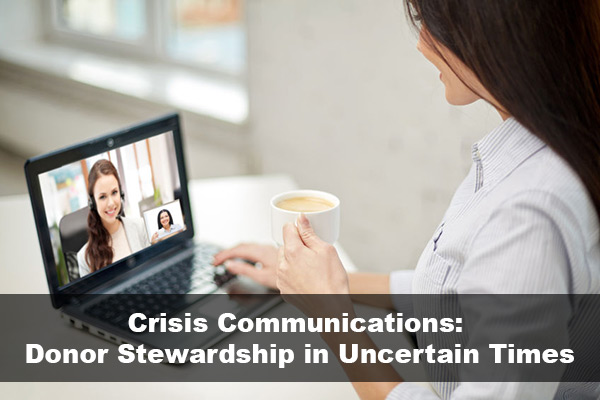When the COVID-19 pandemic first made headlines, there were many unknown factors for nonprofits. From how it would affect charitable donations to how long working from home would last, nonprofit professionals everywhere were unsure of where the crisis would lead them.
In response, many organizations paused their efforts. They halted fundraising campaigns and instead raised gifts for emergency funding and the pandemic response. Further, they stopped stewarding donors— at least in the manner they were before— to brainstorm socially distanced alternatives.
Now, a few months into the crisis, there’s only one thing we can be certain about: The challenging landscape caused by COVID-19 is sticking around for the near future.
With this in mind, it’s time to resume operations. Your nonprofit’s mission is still essential, and you can’t pause your fundraising efforts indefinitely! However, that doesn’t mean you can approach them as if circumstances were normal.
Create a new, fresh strategy that allows your organization to continue persevering through the uncertain landscape created by COVID-19. Rather than waiting for the crisis to pass, revitalize your efforts to position your organization to emerge successful in the next 6 to 12 months.
In this guide, we’re going to cover one aspect of revitalizing your strategy: donor stewardship. Because so many nonprofit efforts stem from strong relationships with supporters, this is a great place to start!
Are you ready to restructure your donor stewardship efforts and give your organization the best chance for success in this uncertain landscape?
Let’s dive in.
1. Revisit Your Donor Stewardship Calendar
When you first outlined a calendar for 2020, you likely blocked out segments of your year for different donor stewardship activities. This may have included dates:
- To hold donor stewardship and acknowledgment campaigns.
- To begin stewardship of planned giving prospects.
- To begin soliciting donations for a specific fundraising campaign.
- To hold feasibility studies and other major campaign communication efforts.
- And more!
If you developed one of these calendars, you probably had a method behind scheduling these stewardship campaigns in the order that you did. You may have planned to prioritize major donor stewardship to kick off the quiet phase of your capital campaign. Or, maybe you planned a letter-writing campaign to thank your supporters midway through the year, as a follow-up to the efforts they made during the first half of the year.
Regardless, the reasoning behind the scheduling of your donor stewardship campaigns might have been quickly forgotten with the outset of the COVID-19 pandemic.
Just as fundraising initiatives needed to be rerouted and in-person events had to pivot, your donor stewardship efforts should be adjusted to fit the new 2020, one impacted by the pandemic. We’re not suggesting canceling these efforts— far from it— but rather, repositioning and reordering them to position your organization for the most success over the remainder of the calendar year.
Also read: Choosing the Right Fundraising Campaign: 5 Tips for 2020
2. Adjust Your Messaging
If your organization halted all fundraising and donor stewardship efforts in light of the crisis, we recommend revisiting your messaging before proceeding with your new communications calendar.
Here are a few reasons why:
- Just as the crisis is impacting your team, it has likely impacted your donors as well. Stress levels may be high, and it’s important to prepare your team to respond.
- Your donors want to know how your nonprofit has been affected. Prepare to answer questions about your fundraising and how advancing your mission has been impacted due to the crisis.
- Your pre-COVID messaging may not be ideal to use during the crisis. There is a definite risk of sounding “tone-deaf” if your messaging doesn’t acknowledge the current challenges.
First and foremost, ensure your staff and volunteers are prepared with messaging that’s empathetic and informative, without downplaying your organization’s need for gifts. These team members should be ready to hear the word “no” and should be comfortable holding conversations with donors who may have fallen on hard times.
Further, any prepared communications materials— think social media posts, cases for support, fundraising brochures, email newsletters, etc.— should be altered to be mindful of the current landscape.
3. Add a New Dimension to One-On-One Meetings
At this point, we’ve discussed your stewardship efforts in a more bird’s-eye view manner— focusing on your calendar and messaging overall. Now, let’s dive into some specifics.
One-on-one meetings and conversations with key stakeholders are one of the most powerful stewardship methods. There’s something about speaking with someone face-to-face and building a rapport about your organization and its mission that forges strong connections— significantly stronger than other types of communication.
When social distancing measures were mandated in response to the COVID-19 pandemic, seemingly overnight these infinitely valuable in-person meetings, luncheons, office visits, and “Let’s grab a coffee”’ outings were wiped from the calendar.
Let’s be frank: these one-on-one conversations develop connections that are crucial for continuing to thrive despite the challenges of COVID-19. What does that mean for your organization? It’s time to get creative!
Rather than emailing a donor, simply pick up your phone and call them. Or, perhaps even better, schedule a “face-to-face” meeting via video conferencing software. As a society, we’re feeling more “distant” than ever before. Your donors will appreciate the additional effort, the friendly face and the ability to continue learning about your organization during challenging times.
4. Make the Most of the Assets You Already Have
If you’re like many nonprofit organizations across the nation, you probably sent most of your staff, volunteers, and board members home to continue contributing at a safe distance. How can you craft a strong story to steward donors, both current and new, when your team is more distant than ever before?
Dive into your archives! We all know that there is much more involved in the work of a nonprofit organization than meets the eye. Access archival information of your work from years past to build a narrative around the necessity of your nonprofit. Consider the following examples:
- Collect behind-the-scenes photos and videos of your nonprofit’s staffers and volunteers at work. Show donors how their gifts were put to action!
- Write a narrative about past fundraising campaigns. Walk supporters through how the campaign played out— from the first donation to the final impacts.
- Highlight a volunteer or team member. Ask them to share photos, videos, and testimonies about their experience with your organization. Not only is this an outreach method, but also an opportunity to show appreciation for current team members. So, while stewarding new donors, you’ll improve the retention of current donors as well!
Then, share this information widely across your nonprofit’s website and most importantly, your social media networks.
Social media isn’t a replacement for other crucial stewardship efforts (such as the aforementioned conversations). However, the COVID-19 pandemic has had an interesting impact on social media.
Across the board, users on all social networks reported that their platform usage would increase during COVID-19— understandable, considering it’s one of the few safe methods of social connection during the crisis. Sharing information on social media allows your nonprofit to make the most of this trend.
Also read: What If? Crisis Response Planning for Your Nonprofit
5. Get the Entire Team on Board
During normal operations, your nonprofit’s leadership and board members would be recruited to build connections with your most major, impactful donors. Lunches, coffee meetings, and dedicated tours would be scheduled, during which your leadership would advocate for your organization, share history, and discuss the details of large gifts.
Don’t cancel these meetings simply because donors and leadership can’t meet in person. Instead, challenge your leaders and board members to step out of their comfort zone with technology-assisted meetings.
Once again, draw on video conferencing and broadcast software to connect your supporters with your nonprofit’s leadership. To learn more about this and other virtual fundraising software, check out this guide.
From there, consider including your nonprofit’s leadership in other aspects of donor stewardship that they may not have participated in previously. Would your board members be willing to submit a video testimonial to share on social media?
Stewarding donors during a crisis is a challenge, and it’s one that your entire team should be united in surpassing. That includes your leadership!
Now, a few months into the crisis, we’re seeing that the uncertainty caused by the COVID-19 pandemic is staying around for the near future. Rather than waiting for the dark clouds to pass, it’s time for your nonprofit to rethink its strategies for success in spite of the challenge.
As you now know, donor stewardship is a great place to start, as all of your nonprofit’s efforts stem from strong donor relationships. With these tips, you’ll build a strong foundation for stewarding donors during these trying times.
About the Author:
Long before Aly Sterling founded her eponymous consulting firm, she was solving the unique yet similar problems encountered by nonprofit organizations.
Her decision to start her own business in 2007 was driven by her belief in leadership as the single most important factor in organizational success, and her determination to work with multiple causes at one time to scale societal change.
Aly’s expertise includes fundraising, strategic planning, search consultation and board leadership development for the well-positioned nonprofit. She is regularly sought for comment by trade and mainstream media, including the Chronicle of Philanthropy and U.S. News & World Report. She has contributed to publications of BoardSource and The Governance Institute, as well as the Toledo Chamber of Commerce and The Giving Institute.
Check out this Aly Sterling Philanthropy guide for more information about hiring a fundraising consultant.


